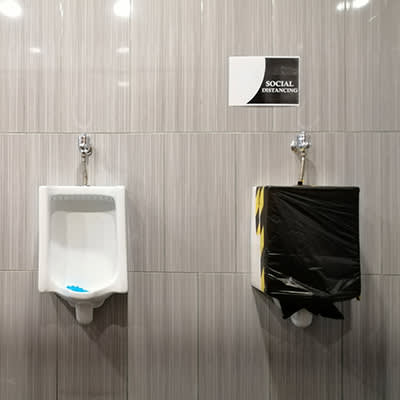
For an enhanced digital experience, read this story in the ezine.
Some people will experience fear or anxiety when using a public restroom in the coronavirus (COVID-19) era. During this time, we should strive to protect visitors the best we can. Here are some ways to keep your public restrooms safe during the COVID-19 pandemic:
Restrict Access to Some Fixtures to Create Separation Between Users
The Centers for Disease Control and Prevention (CDC) has broadly recommended people keeping a distance of six feet from all others at all times, when possible. Unfortunately, most restrooms were not designed with this kind of distancing in mind — sinks and urinals are generally about half that distance away from each other. By taping off or covering every other sink or urinal, it sends a very clear message for users to avoid them.
Emphasize Paper Towels Over Hand Dryers
It is believed that COVID-19 spreads primarily through tiny water droplets expelled through the breath of infected individuals. Hand dryers produce high-speed turbulence that could hypothetically keep these droplets suspended in the air indefinitely, keeping the air within the restroom unsafe.
Some have claimed that this increases viral load into breathable air, but there appears to be no study linking COVID-19 cases with hand dryers. Both the CDC and World Health Organization (WHO) approve of hand dryers. It’s safe to assume those organizations value hand drying over any real or hypothetical threats from hand dryers.
Unlike hand dryers, paper towels are not controversial. There are maintenance drawbacks with the waste and restocking, but the only potential health risk is if the paper towels run out. Additionally, paper towels are also great because they can be used to open the door after using the restroom.
Remove as Much Surface Contact as Possible
Replace existing fixtures with hands-free activators. This could include toilets, urinals, faucets, soap dispensers, paper towel dispensers and hand-sanitizing liquid dispensers. Typically, these are battery operated and some are relatively easy to install. If possible, keep the entry door open (or remove it completely). For outdoor restrooms, consider using a privacy screen in front of the entrance to maintain privacy with an open door.
Frequently Refill Soap and Hand-Sanitizer Dispensers
With people washing their hands at higher rates than before, there may be people going into your restroom just to wash their hands and nothing else! You can expect these supplies to need more frequent maintenance than in years past. This is one of the simpler, yet more critical, things you can do to make your restroom safer.
Maximize Ventilation
Introducing outside air into the restroom space through ventilation can remove airborne droplets quickly. This is the easiest and most effective way to reduce airborne transmission of pathogens. Therefore, make sure that you have open windows and vents in the restroom. If you have a bathroom fan, it should be set to run continuously.
Disinfect Fixture Handles and Buttons Frequently
Transmission of coronavirus may come from touching common surfaces that an infected person had previously touched. We recommend frequent disinfection of any permanent surface a visitor might touch with their hands, particularly the door handles on the stalls and entry door.
Easing the Public’s Concerns
It’s best to find ways to keep your visitors at safe distances while minimizing their need to touch things and maximizing the air flow and access to hand sanitation. If precautions are taken, users should feel reasonably safe using public restrooms.
Kip Earlywine is Blog Editor for Green Flush Restrooms.
Editor's Note: The section "Emphasize Paper Towels Over Hand Dryers" has been updated from the original to reflect current information and guidance regarding hand-washing safety.


